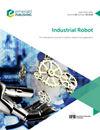基于杂交神经网络的辅助机器人气动人工肌肉行为建模
IF 2.5
4区 计算机科学
Q3 ENGINEERING, INDUSTRIAL
Industrial Robot-The International Journal of Robotics Research and Application
Pub Date : 2022-06-10
DOI:10.1108/ir-03-2022-0060
引用次数: 1
摘要
本文旨在设计一种史无前例的方法来确定辅助机器人应用的气动人工肌肉(PAMs)的设计、操作条件和驱动策略。这需要在PAM特征和设计变量之间进行广泛的表征、数据集生成和有意义的建模。这样的表征应该涵盖广泛的设计和操作参数。这是为这种非常受欢迎的柔性执行器生成设计指南的踏脚石,就像任何传统的机械元件一样。设计/方法论/方法对大量定制制造的不同设计的pam进行表征,以确定其静态和动态行为。采用基于元启发式优化器的人工神经网络(ANN)结构确定了8种不同的PAM行为模型。水平行走时膝关节屈曲的辅助目标是通过在关节上附加PAM来评估所开发的驱动器的适用性。在此基础上,通过桌面仿真对PAM的设计和驱动策略进行了优化。通过人工神经网络成功地模拟了pam的被动长度、静态收缩、动态膨胀和收缩阶跃响应与设计尺寸和运行参数的关系。研究了这些模型的有效性,成功地优化了PAM的设计、操作参数和驱动策略,以实现PAM辅助人体膝关节屈曲的步态。原创性/价值在广泛的操作条件下,具有不同设计的大型pam池的静态和动态行为的特征是本文的新颖之处。讨论了一种清晰的可定制制造技术,以获得各种各样的PAM设计。基于元启发式的人工神经网络用于在建模PAM行为时处理数据中的高度非线性。一个创新的桌面模拟器用于研究模型在pam在辅助机器人中的可能应用中的效用。本文章由计算机程序翻译,如有差异,请以英文原文为准。
Hybridized neural network inspired behavioural modelling of pneumatic artificial muscles for assistive robotic applications
Purpose
This paper aims to devise a first-of-its-kind methodology to determine the design, operating conditions and actuation strategy of pneumatic artificial muscles (PAMs) for assistive robotic applications. This requires extensive characterization, data set generation and meaningful modelling between PAM characteristics and design variables. Such a characterization should cover a wide range of design and operation parameters. This is a stepping stone towards generating a design guide for this highly popular compliant actuator, just like any conventional element of a mechanism.
Design/methodology/approach
Characterization of a large pool of custom fabricated PAMs of varying designs is performed to determine their static and dynamic behaviours. Metaheuristic optimizer-based artificial neural network (ANN) structures are used to determine eight different models representing PAM behaviour. The assistance of knee flexion during level walking is targeted for evaluating the applicability of the developed actuator by attaching a PAM across the joint. Accordingly, the PAM design and the actuation strategy are optimized through a tabletop emulator.
Findings
The dependence of passive length, static contraction, dynamic step response for inflation and deflation of the PAMs on their design dimensions and operating parameters is successfully modelled by the ANNs. The efficacy of these models is investigated to successfully optimize the PAM design, operation parameters and actuation strategy for using a PAM in assisting knee flexion in human gait.
Originality/value
Characterization of static and the dynamic behaviour of a large pool of PAMs with varying designs over a wide range of operating conditions is the novel feature in this article. A lucid customizable fabrication technique is discussed to obtain a wide variety of PAM designs. Metaheuristic-based ANNs are used for tackling high non-linearity in data while modelling the PAM behaviour. An innovative tabletop emulator is used for investigating the utility of the models in the possible application of PAMs in assistive robotics.
求助全文
通过发布文献求助,成功后即可免费获取论文全文。
去求助
来源期刊
CiteScore
4.50
自引率
16.70%
发文量
86
审稿时长
5.7 months
期刊介绍:
Industrial Robot publishes peer reviewed research articles, technology reviews and specially commissioned case studies. Each issue includes high quality content covering all aspects of robotic technology, and reflecting the most interesting and strategically important research and development activities from around the world.
The journal’s policy of not publishing work that has only been tested in simulation means that only the very best and most practical research articles are included. This ensures that the material that is published has real relevance and value for commercial manufacturing and research organizations. Industrial Robot''s coverage includes, but is not restricted to:
Automatic assembly
Flexible manufacturing
Programming optimisation
Simulation and offline programming
Service robots
Autonomous robots
Swarm intelligence
Humanoid robots
Prosthetics and exoskeletons
Machine intelligence
Military robots
Underwater and aerial robots
Cooperative robots
Flexible grippers and tactile sensing
Robot vision
Teleoperation
Mobile robots
Search and rescue robots
Robot welding
Collision avoidance
Robotic machining
Surgical robots
Call for Papers 2020
AI for Autonomous Unmanned Systems
Agricultural Robot
Brain-Computer Interfaces for Human-Robot Interaction
Cooperative Robots
Robots for Environmental Monitoring
Rehabilitation Robots
Wearable Robotics/Exoskeletons.

 求助内容:
求助内容: 应助结果提醒方式:
应助结果提醒方式:


